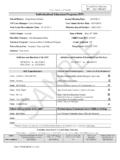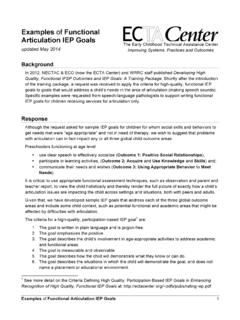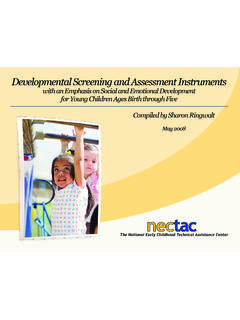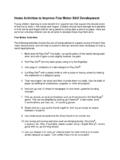Transcription of A Guide to the Implementation Process: Stages, …
1 A Guide to the Implementation Process: Stages, Steps and activities page 1 A Guide to the Implementation Process: Stages, Steps and activities ECTA Center Work Team on Implementation Process: Barbara Smith, Joicey Hurth, Lynda Pletcher, Evelyn Shaw, Kathy Whaley, Mary Peters and Glen Dunlap March 25, 2014 The ECTA Center is a program of the FPG Child Development Institute of the University of North Carolina at Chapel Hill, funded through cooperative agreement number H326P120002 from the Office of Special Education Programs, Department of Education. Opinions expressed herein do not necessarily represent the Department of Education's position or policy. For more information about the ECTA Center, please contact us at: Campus Box 8040, UNC-CH Chapel Hill, NC 27599-8040 919-962-2001 phone 919-966-7463 fax email web Project Directors: Lynne Kahn & Christina Kasprzak Project Officer at OSEP: Julia Martin Eile A Guide to the Implementation Process: Stages, Steps and activities page 2 A Guide to the Implementation Process: Stages, Steps and activities Table of Contents Introduction.
2 4 Planning for Change .. 6 Stage 1: Exploration .. 7 Step 1: Establish a State Leadership Team (SLT) to Guide exploration .. 7 Step 2: The SLT convenes a stakeholder group for needs assessment and system analysis .. 7 Step 3: Stakeholders explore the feasibility and "fit" of potential innovations and practices .. 8 Step 4: The SLT decides on practices/innovation and whether or not to proceed .. 8 Step 5: The SLT secures agency and cross-agency leadership support .. 8 Outcomes of Exploration .. 8 Stage 2: Installation .. 9 Step 1: The SLT finalizes membership and responsibilities .. 9 Step 2: The SLT develops a communication plan for statewide buy-in .. 9 Step 3: The SLT establishes Implementation Sites and Teams .. 9 Step 4: The SLT develops system supports and infrastructure changes .. 10 Step 5: The SLT improves data systems, evaluation and monitoring .. 10 Step 6: The SLT builds Training and Technical Assistance (T&TA) capacity; begins training.
3 10 Step 7: The SLT finalizes a written plan .. 10 Outcomes of Installation .. 10 A Guide to the Implementation Process: Stages, Steps and activities page 3 Stage 3: Initial Implementation .. 11 Step 1: State TA providers train and coach Implementation Site personnel .. 11 Step 2: Implementation teams support practitioners and monitor the use of new practices .. 11 Step 3: The SLT and Implementation Teams use feedback loops and improvement cycles to adjust organizational supports .. 11 Step 4: The SLT and Implementation Teams evaluate fidelity, and emerging outcomes .. 12 Outcomes of Initial Implementation .. 12 Stage 4: Full Implementation .. 12 Step 1: Site Implementation Teams maintain T&TA supports .. 12 Step 2: The SLT and Implementation Teams ensure that data systems, policies, procedures and funding are integrated and functioning .. 13 Step 3: Implementation Teams regularly use performance assessment.
4 13 Step 4: The SLT and Implementation Teams use feedback and data to sustain fidelity .. 13 Step 5: The SLT and Site Implementation Teams ensure on-going sustainability of structures and practices .. 13 Outcomes of Full Implementation .. 13 Stage 5: Expansion/Scale-up .. 14 Step 1: Initial Implementation Sites assist the SLT in expansion .. 14 Step 2: The SLT selects new sites and provides necessary supports .. 14 Step 3: New sites begin their Implementation process .. 14 Step 4: The SLT establishes mechanisms for sustaining fidelity of practices .. 15 Outcomes of Expansion and Scale-up .. 15 A Guide to the Implementation Process: Stages, Steps and activities page 4 A Guide to the Implementation Process: Stages, Steps and activities Introduction Implementation : The process of moving an idea from concept to reality (Webster s Collegiate Dictionary) Improving child and family outcomes is a cornerstone of early childhood education and in particular the IDEA Part C and Part B, Section 619 Preschool programs.
5 To improve outcomes, an evidence-based practice or i nnovation must be selected and the process of implementing that practice or innovation must be effective. Implementation science is the study of the processes needed to bring new practices into widespread use. Changing policies or guidelines, providing information and training alone are not adequate to bring about sustainable changes in practice. To adopt evidence-based practices, the Implementation process must also address the organizational supports which are necessary to initiate and sustain the practices with fidelity. Through carefully planned Implementation , the adoption of any new practices builds the system s capacity for change. The stages described in the Guide include: 1) exploration, 2) installation, 3) initial Implementation , 4) full Implementation , and 5) expansion and scale-up. Each stage has specific steps and associated activities . While the stages, steps and activities suggest a linear sequence of events, in actual Implementation there is often a more dynamic flow to the work.
6 Some stages or steps may be occurring simultaneously and the work often circles back to revisit earlier stages. Implementation drivers such as technical leadership and adaptive leadership, organizational supports and personnel development mechanisms must align with and support the new practices. This Guide is based on a review of the literature of Implementation science (Fixsen, Naoom, Blase, Friedman, & Wallace, 2005) and the collective experiences of federally funded national centers in conducting state-wide system change initiatives. These centers include the National Early Childhood Technical Assistance Center (NECTAC, now the ECTA Center), Technical Assistance Center on Social Emotional Intervention for Young Children (TACSEI), Center on the Social and Emotional Foundations for Early Learning (CSEFEL), National Implementation Research Network (NIRN) and the State Implementation of Scaling-Up Evidence-based Practices (SISEP). Note: Implementation science terminology used in the document is defined in an online glossary.
7 All glossary terms are highlighted and linked to this glossary the first time used. An online version of this Guide and glossary are available at: A Guide to the Implementation Process: Stages, Steps and activities page 5 References Fixsen, , Naoom, , Blase, , Friedman, , & Wallace, F. (2005). Implementation research: A synthesis of the literature. Tampa, FL: University of South Florida, Louis de la Parte Florida Mental Health Institute, The National Implementation Research Network (FMHI Publication 231). Downloadable at Halle, T., Metz, A. & Martinez-Beck, I. (Eds.), (2013). Applying Implementation science in early childhood programs and systems. Baltimore, MD: Paul H. Brookes Publishing Company. Metz, A. & Bartley, L. (2013). Active Implementation frameworks for program success: How to use Implementation science to improve outcomes for children. Zero to Three, March 2012. National Centers ECTA Center Center on the Social and Emotional Foundations for Early Learning (CSEFEL) National Implementation Research Network (NIRN) State Implementation of Scaling-Up Evidence-based Practices (SISEP) Technical Assistance Center on Social Emotional Intervention for Young Children (TACSEI) A Guide to the Implementation Process: Stages, Steps and activities page 6 Planning for Change Change is complex and dynamic.
8 It involves moving or transforming from something familiar to something new. Change can be broad, affecting multiple practices or aspects of the program, or it might be narrow, affecting fewer practices. Regardless of the scale, change is a dynamic active and on-going process, rather than a single event. There are many reasons for programs or agencies to engage in a change process. Some of these may include: A newly defined vision or direction A crisis A new mandate Data that supports a change is needed New information and/or research Old ways are not getting the needed or desired outcomes New leadership bringing different practices The push to change can come from any level of the organization. Regardless of where the initial push comes from, it is essential that a change effort is carefully planned. It is important that program and agency leaders first examine the current organizational and political climate to assess readiness to both begin and sustain Implementation and scaling up (or expansion) of new practices or an innovation.
9 This examination should include: Identification of key stakeholders who share the interest and need for change Assessment of the degree to which these stakeholders perceive the issue or need to be a priority Willingness of leadership from multiple agencies and programs to support the change process over a period of time Identification of a leadership team responsible for the oversight of necessary aspects of the change process over time Desire to engage in discussions and gather information about potential solutions to identified needs Knowledge of Implementation science and its application to the change process It is important to recognize that, planning and engaging in the Implementation of any new innovation, evidence-based practice, or cluster of practices takes time, energy and resources. The change process can be understood and organized using defined steps and subsequent activities that are needed to move a concept into reality.
10 These steps and activities are outlined in the following document, "A Guide to the Implementation Process: Stages, Steps and activities ". A Guide to the Implementation Process: Stages, Steps and activities page 7 Stage 1: Exploration The goals of the exploration stage are to identify the need for change, determine what innovation or set of practices are likely to meet that need, and to decide whether or not to move ahead with the Implementation process. This stage, and all other stages, are guided by a State Leadership Team. The State Leadership Team (SLT) should include cross- sector representation of agencies and programs impacted by the proposed initiative. The composition, vision and mission of this initial team may change over time as they go through the stages and steps. The SLT ensures that the perspectives of key stakeholders from every level of the service system are included as a part of a needs assessment of the current service delivery system.

















